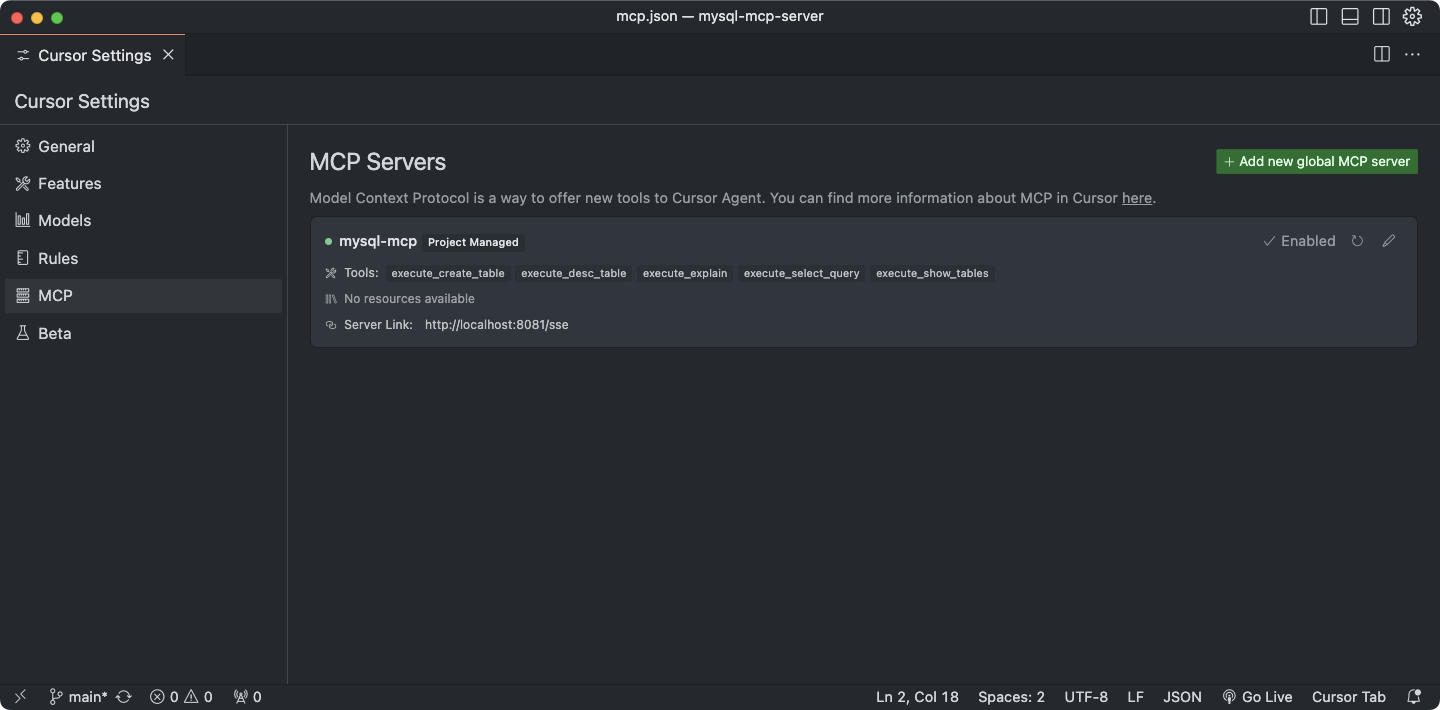Supports containerized deployment of the MCP server through Docker, allowing configuration of database connection parameters and port mappings.
Provides environment variable management for configuring database credentials and server settings through .env files.
Includes Mermaid diagram support for visualizing the server architecture and data flow between components.
Enables AI models to interact with MySQL databases by providing tools for executing SQL queries, creating tables, describing table schemas, getting query execution plans, and listing available tables.
Integrates with pandas for processing and analyzing database query results before returning them to AI models.
Built with Python, allowing direct execution of the server outside of Docker containers and easy extension through Python-based tools.
mysql-mcp-server
0. Execution
Running with Docker
Change the database connection information as needed.
Running with Docker Compose
This will proceed with a pre-configured setup.
Running directly with Python
Cursor Configuration
MCP functionality is available from Cursor version 0.46 and above.
Additionally, the MCP feature is only accessible to Cursor Pro account users.

Tool Addition Tips
Adding a Tool
executefunctions implement the actual logic execution (Service Layer).The
@tooldecorator helps register the tool with MCP (Controller Layer).
Explanation
Each file under
mysql_mcp_server/executorsrepresents a single tool.If a new tool is added, it must be imported in
mysql_mcp_server/executors/__init__.pyand included in the__all__array.This ensures the module is automatically registered in the
TOOLS_DEFINITIONvariable.
Related MCP server: MCP MySQL Server
🚧 Development Roadmap 🚧
⚙️ Parameter Options
🔧 Enable/Disable Switch for Each Tool: Provide a function to reduce Input Context costs 💰
🔒 Query Security Level Setting: Offer optional control over functions that could damage asset value, such as DROP, DELETE, UPDATE 🚫
✨ Features
📊 Data Analysis Report Generation: Provide a report generation function optimized for the model to appropriately select various charts based on user requests 📈
📝 Reporting capabilities for prescribed forms
🖌️ Diversify report templates
🗄️ Extended Text2SQL Support
🌐 SSH Connection Support: Enable secure remote access via SSH for advanced operations 🔑
📥 File Extraction Function
📄 CSV
📑 JSON
📉 Excel
1. Overview
MCP MySQL Server is a server application for MySQL database operations based on MCP (Model Context Protocol). This server provides tools that allow AI models to interact with the MySQL database.
2. System Configuration
2.1 Key Components
MCP Server: A FastMCP server that communicates with AI models
MySQL Database: Manages and stores data
Tools: Executors that perform database operations
2.2 Tech Stack
Language: Python
Database: MySQL 8.0
Key Libraries:
mcp: Implements Model Context Protocol for AI communication
PyMySQL: Connects to MySQL and executes queries
pandas: Processes and analyzes data
python-dotenv: Manages environment variables
fire: Implements command-line interfaces
2.3 Deployment Environment
Containerized deployment via Docker and Docker Compose
Ports: 8081 (MCP Server), 3306 (MySQL)
3. Directory Structure
4. Architecture Design
4.1 Layered Structure
Interface Layer: MCP Server (FastMCP)
Business Logic Layer: Handlers and Executors
Data Access Layer: Database connection and query execution
4.2 Key Classes and Modules
MySQLMCPServer: Main server class that initializes and runs the MCP server
DatabaseManager: Singleton pattern-based database connection manager
Executors: Collection of tools for database operations
execute_create_table: Creates tables
execute_desc_table: Checks table schema
execute_explain: Provides query execution plans
execute_insert_query: Executes INSETR queries
execute_select_query: Executes SELECT queries
execute_show_tables: Retrieves table lists
4.3 Communication Flow
AI model requests a list of available tools from the MCP server.
The server returns the available tools list.
The AI model requests the execution of a specific tool.
The server calls the corresponding executor to perform the database operation.
The execution results are returned to the AI model.
5. Scalability and Maintenance
Adding Tools: Implement new tools in the
executorsdirectory and register them in__init__.py.Environment Configuration: Manage environment variables via the
.envfile.Logging: Ensure consistent logging using
logger_helper.
6. Deployment and Execution
6.1 Local Execution
6.2 Docker Deployment
7. Security Considerations
Manage database credentials via environment variables.
Use strong passwords in production environments.
Consider implementing SSL/TLS encryption for database connections when necessary.